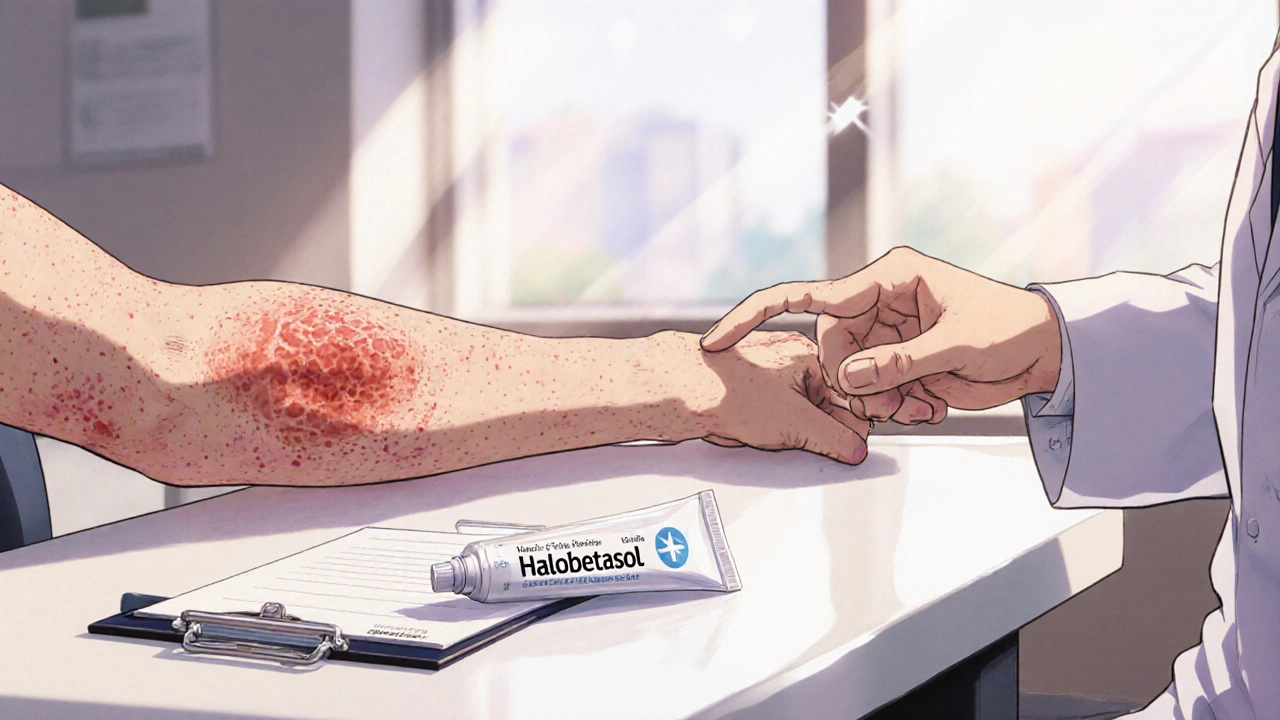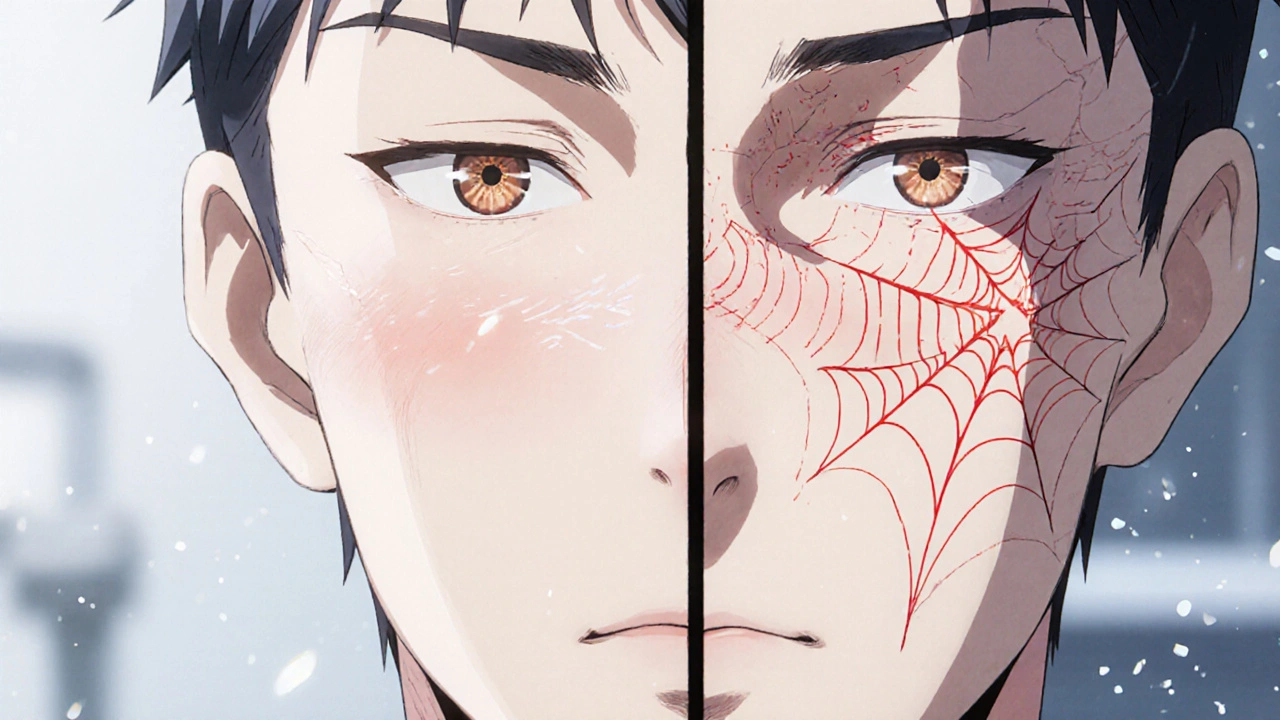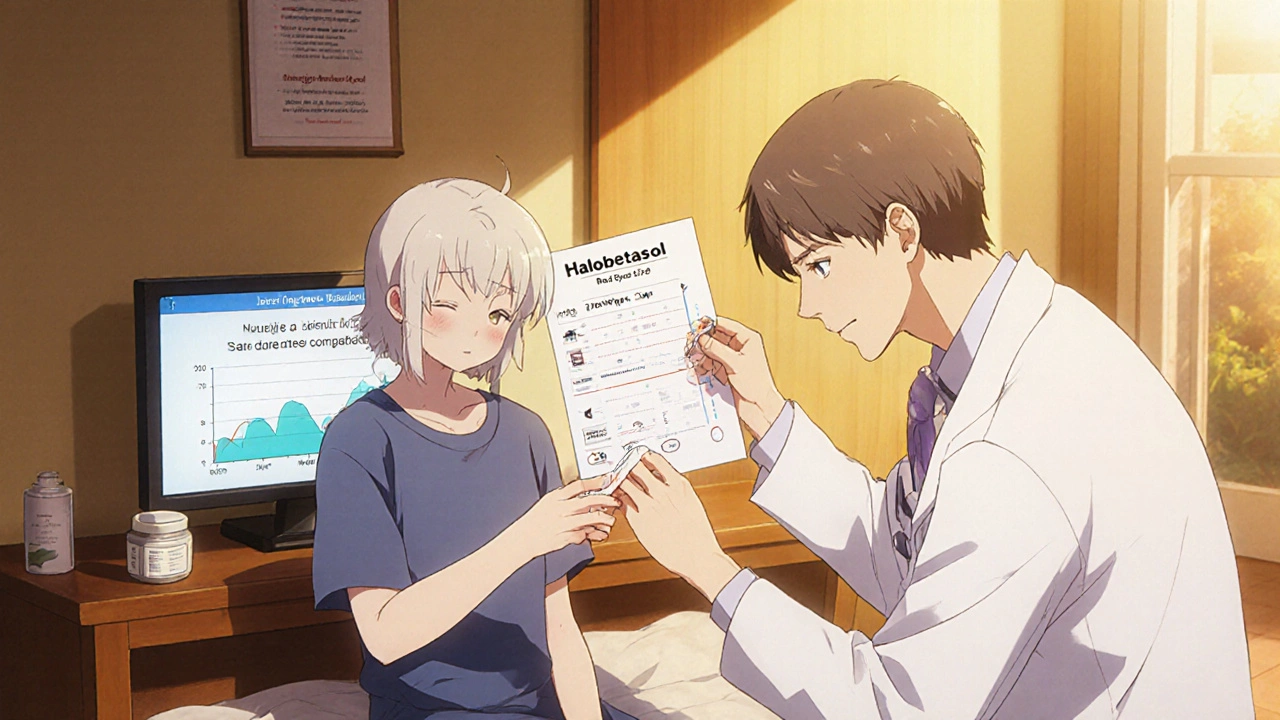Halobetasol Safety Profile: Risks, Side Effects & Clinical Insights

Halobetasol Body Surface Area Calculator
Calculate the percentage of body surface area being treated to ensure safe halobetasol use. Treatment should not exceed 10% BSA for more than 2 weeks to minimize systemic absorption risk.
Select Body Areas Being Treated
Please select the body areas being treated to calculate your percentage.
When you pick a prescription cream for stubborn skin flare‑ups, you want to know exactly how safe it is. Halobetasol is a super‑potent topical corticosteroid used for conditions like psoriasis and eczema. Understanding its safety profile means looking at how it works, who’s most likely to feel side effects, and what doctors do to keep risks low.
What Halobetasol Is and How It Works
Halobetasol belongs to the Corticosteroid family, a group of hormones that mimic the body’s natural cortisol. When applied to skin, it reduces inflammation by dampening the immune response, shrinking blood‑vessel dilation, and blocking the release of inflammatory mediators. Its chemical structure, a halogen‑substituted propionate, gives it a very high affinity for the glucocorticoid receptor, which translates into a potency rating of “super‑potent” (class I) in the Topical steroid potency scale.
Typical Indications and Treatment Duration
Clinicians mainly prescribe halobetasol for:
- Severe plaque psoriasis
- Chronic atopic dermatitis that hasn’t responded to lower‑strength steroids
- Lichen planus and other inflammatory dermatoses
The drug is intended for short‑term bursts-usually no more than two weeks. Prolonged use can tip the balance toward adverse effects, especially when large surface areas are treated.
Key Safety Concerns
Even though halobetasol is powerful, most side effects are predictable and manageable if you follow best practices.
- Skin atrophy: Thinning of the epidermis and loss of collagen can happen under occlusive dressings or with daily use over a month. Patients often notice stretch marks or a shiny appearance.
- Telangiectasia: Small, visible blood vessels may appear on the treated area, especially on thin skin such as the face.
- Hypopigmentation: The drug can suppress melanocyte activity, leading to lighter patches.
- Systemic absorption: When applied to large areas, broken skin, or under occlusion, a measurable amount can enter the bloodstream. This raises the risk of HPA axis suppression, which may cause adrenal insufficiency.
- Rebound flare: Stopping abruptly after long use can trigger a flare‑up that looks worse than the original condition.
Systemic Risks and the HPA Axis
The hypothalamic‑pituitary‑adrenal (HPA) axis is the body’s internal cortisol regulator. High‑potency steroids can signal the brain to cut back its own cortisol production, a phenomenon called adrenal insufficiency. Clinical studies from the FDA show that systemic levels become significant when more than 10% of body surface area is covered for over two weeks. In practice, doctors mitigate this by rotating to a lower‑strength steroid or a non‑steroidal anti‑inflammatory after the initial burst.

Comparing Halobetasol with Other Super‑Potent Steroids
| Drug | Potency (Class) | Typical Indications | Max Recommended Duration | Systemic Absorption Risk |
|---|---|---|---|---|
| Halobetasol | Class I | Psoriasis, severe eczema | 2 weeks | Low‑moderate (large‑area use) |
| Clobetasol propionate | Class I | Lichen planus, psoriasis | 2 weeks | Low‑moderate |
| Betamethasone dipropionate | Class II (high‑potency) | Eczema, dermatitis | 4 weeks | Very low |
Notice that while halobetasol and clobetasol share the same class‑I potency, betamethasone sits a step lower, which often translates into a slightly safer long‑term profile. However, the clinical choice still hinges on how aggressively you need to quell inflammation.
Practical Tips to Minimize Risks
- Use the smallest amount needed to cover the lesion (“fingertip unit” method).
- Avoid occlusive dressings unless specifically instructed.
- Limit treatment to 2 weeks; then switch to a medium‑potency steroid or a non‑steroidal option.
- Monitor for early signs of skin thinning-check two weeks after starting.
- If treating >10% BSA, consider baseline cortisol testing and periodic follow‑up.
Following these steps keeps the halobetasol safety profile well within acceptable limits for most patients.
Regulatory Perspective and Recent Findings
The U.S. Food and Drug Administration (FDA) classifies halobetasol as a prescription‑only medication, citing its high potency and potential for systemic effects. A 2023 post‑marketing surveillance study involving 1,200 users reported a 1.8% incidence of mild HPA‑axis suppression, all of which resolved after discontinuation. No serious adrenal crises were recorded, underscoring that vigilant prescribing curbs severe outcomes.

When to Avoid Halobetasol
Contra‑indications include:
- Active viral, bacterial, or fungal skin infections (the steroid can worsen them).
- Rosacea or perioral dermatitis, where steroids typically aggravate the condition.
- Pregnant or breastfeeding patients without specialist guidance.
- Children under two years of age-skin absorption is higher.
In these cases, physicians usually opt for milder steroids or calcineurin inhibitors.
Frequently Asked Questions
Can I use halobetasol on my face?
Generally, doctors avoid super‑potent steroids on the face because the skin is thin and more prone to atrophy. If a dermatologist prescribes it, they’ll limit use to a few days and monitor closely.
What should I do if I notice skin thinning?
Stop the medication immediately and contact your prescriber. They’ll likely switch you to a lower‑strength steroid or a non‑steroidal therapy and assess for any systemic effects.
Is it safe to combine halobetasol with other topical treatments?
Combining with moisturizers or barrier creams is fine and often recommended. However, layering multiple steroids or mixing with tar products can increase irritation and should be avoided unless a specialist advises.
How quickly will I see improvement?
Most patients notice reduced redness and scaling within 3‑5 days. Full clearance of thick plaques can take 1‑2 weeks, depending on severity.
Can halobetasol cause steroid addiction?
Physical dependence isn’t typical with topical use, but psychological reliance can develop if patients repeatedly self‑prescribe for flare‑ups. That’s why medical supervision is crucial.
Bottom Line
Halobetasol offers rapid, powerful relief for tough dermatologic conditions, but its safety hinges on disciplined use. By limiting treatment length, avoiding large‑area application, and watching for early signs of skin changes, most patients enjoy the benefits without serious complications. Always discuss any concerns with your dermatologist before starting or stopping therapy.
James Mali
October 18, 2025 AT 15:48Halobetasol works, but keep it short.
Tracy O'Keeffe
October 22, 2025 AT 17:02Honestly, the whole halobetasol hype is just another glittery mirage of medical marketing-definately overblown. The jargon‑laden brochures promise miracles while hiding the abyss of atrophy. If you value your skin, you should treat this super‑potent potion like a volatile chemical, not a daily moisturizer.
Linda A
October 26, 2025 AT 17:15One might argue that potency is a double‑edged sword; the sharper it cuts, the deeper the scar. Still, a measured burst can quell the inferno of inflammation without leaving a permanent echo.
Joe Moore
October 30, 2025 AT 18:28Big Pharma loves to push super‑potent steroids like halobetasol because they lock patients into endless cycles of dependence. They hide the systemic risks behind glossy pamphlets while the real agenda is profit, not health.
Ayla Stewart
November 3, 2025 AT 19:42The clinical guidelines are pretty straightforward: use the smallest amount needed, limit to two weeks, and avoid covering large body areas. Monitoring for skin thinning early can save you from bigger problems later.
Poornima Ganesan
November 7, 2025 AT 20:55When assessing the safety profile of halobetasol, one must first consider its pharmacodynamic potency, which directly correlates with the risk of cutaneous atrophy. The drug’s high affinity for glucocorticoid receptors ensures rapid suppression of inflammatory cytokines, but that same affinity can precipitate collagen degradation if used indiscriminately. Clinical studies consistently show that skin thinning becomes apparent after just ten days of daily application on thin epidermal sites, especially when occlusive dressings are employed. Moreover, telangiectasia often manifests as fragile capillaries become visible under the compromised dermal matrix. Hypopigmentation is another side effect that arises from melanocyte inhibition, leading to conspicuous lighter patches that may persist long after discontinuation. Systemic absorption, while generally low, is not negligible; applying the cream to more than 10 % of body surface area can elevate serum cortisol levels sufficiently to suppress the hypothalamic‑pituitary‑adrenal axis. This suppression may be asymptomatic initially but can culminate in adrenal insufficiency if the patient abruptly stops the medication after prolonged use. The rebound flare phenomenon is well documented, where abrupt cessation triggers a resurgence of inflammation that can appear more severe than the original lesion. To mitigate these risks, physicians often employ a tapering strategy, alternating halobetasol with medium‑potency steroids or non‑steroidal anti‑inflammatories after the initial two‑week burst. Patient education is crucial: individuals should be instructed to apply only a fingertip‑unit amount, avoid occlusion unless specifically advised, and report any signs of skin thinning promptly. Routine follow‑up visits are advisable, particularly for patients with extensive involvement or pre‑existing skin fragility. In pediatric populations, the risk‑benefit ratio must be carefully weighed, as children have a higher surface‑area‑to‑body‑mass ratio, increasing systemic exposure. Lastly, contraindications such as active infections, rosacea, or perioral dermatitis must be respected, as steroids can exacerbate these conditions. In summary, while halobetasol offers unparalleled efficacy for severe dermatoses, its safety hinges on disciplined, short‑term use, vigilant monitoring, and patient adherence to prescribed limits.
Emma Williams
November 11, 2025 AT 22:08Great summary thanks for the details. I’ll keep it short and simple.
Albert Fernàndez Chacón
November 15, 2025 AT 23:22From a practical standpoint, halobetasol can be a lifesaver when used correctly. It’s important to balance its power with the patient’s skin type and treatment area.
Drew Waggoner
November 20, 2025 AT 00:35The mood of using such a strong cream can feel heavy. It’s best to stay aware of any changes.
Mike Hamilton
November 24, 2025 AT 01:48Halobetasol is like a double edged sword – it cuts through inflammation but can also slice your skin's integrity if misused. Remember to check with a dermatologist before long term use.
Matthew Miller
November 28, 2025 AT 03:02Wow, this cream packs a punch! Use it wisely and you’ll see relief lightning fast.